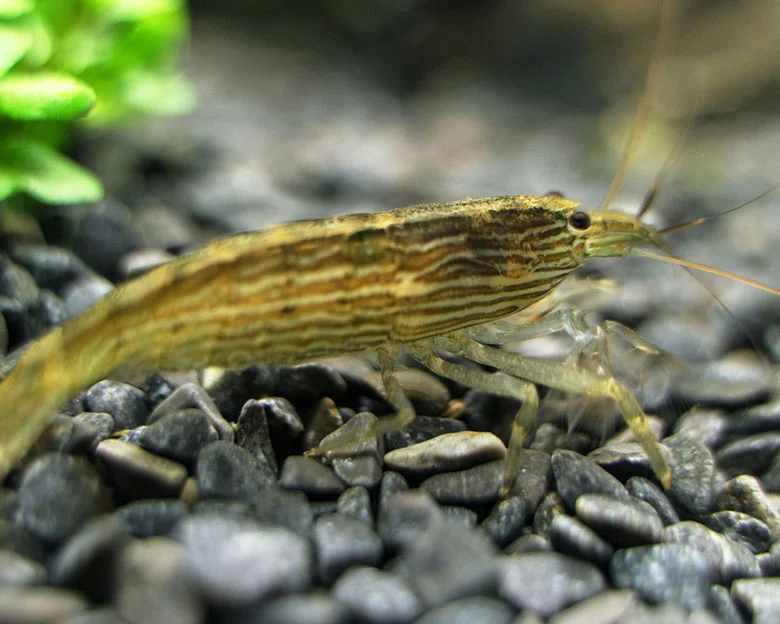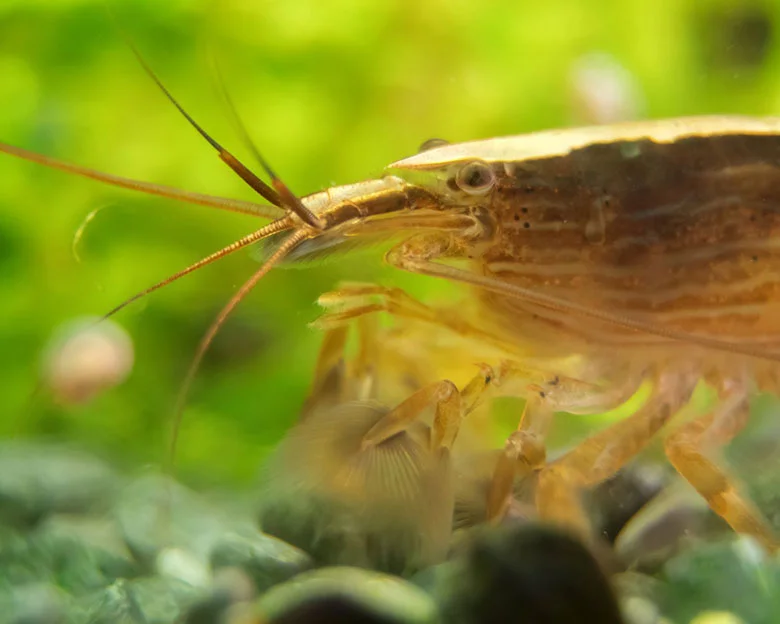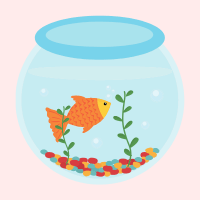Welcome to the world of bamboo shrimp care, where you will discover all you need to know about keeping these fascinating creatures happy and healthy in your aquarium!
Like a gentle stream flowing through a lush bamboo forest, caring for bamboo shrimp requires the perfect balance of knowledge and attention to detail.
Bamboo shrimp, with their distinctive appearance resembling a bamboo plant, are peaceful filter feeders that can thrive in solo or community tanks. To recreate their natural habitat, you’ll need a spacious tank with plenty of water flow, decorations, and aquatic plants for them to perch and filter food from. Monitoring water parameters such as pH, temperature, and hardness is essential to their well-being.
Feeding bamboo shrimp is a unique experience, as they rely on capturing tiny particles of food in the water column. Specialized shrimp food, ground-up shrimp pellets, and algae wafers are all excellent options. In this article, we will delve into the specific requirements for breeding bamboo shrimp, as well as common health issues and the essential supplies you’ll need.
So, grab your metaphorical waders and join us as we dive into the world of bamboo shrimp care, providing you with all the knowledge you need to create the perfect environment for these captivating creatures. Also check out our guide to red cherry shrimp care as well.
Key Takeaways
- Bamboo shrimp are peaceful and can be kept with other snails, fish, and shrimp species.
- They require a tank size of at least 30 gallons with a powerful filter to create a strong current.
- Water parameters such as pH, temperature, and water hardness should be carefully monitored for the health of the shrimp.
- Bamboo shrimp need moderate to medium-hard water and a temperature range of 75-88 °F to thrive.
Appearance and Characteristics

Bamboo shrimp, with their distinctive abdominal segments and dark side stripes, resemble a bamboo plant and have an extensive color range. These peaceful freshwater shrimp can be housed solo or in peaceful community aquariums. They are difficult to breed and require a breeding tank, fertilization, and a nursery tank with brackish water. Bamboo shrimp come in a wide range of colors, including shades of red, brown, and green.
Their coloration can vary depending on their environment and diet. It’s important to note that while bamboo shrimp have specialized needs, they’re relatively easy to care for once their requirements are met. By providing them with the right tank setup, water parameters, and proper feeding, you can ensure their health and longevity.
Ideal Tank Setup
When creating the perfect environment for your aquatic pets, envision a captivating underwater oasis that provides ample space and a gentle current for their graceful perching and efficient filter feeding.
For bamboo shrimp, an ideal tank setup is crucial to their care. One of the key factors is the presence of live plants, which offer numerous benefits. These plants not only enhance the aesthetics of the tank, but they also provide resting spots for the shrimp while they filter feed. Sturdy plants anchored to rocks are recommended, as they can withstand the shrimp’s constant perching.
In addition to live plants, water flow is of utmost importance. A powerful filter should be installed to create a strong current in the tank, allowing the shrimp to efficiently filter food particles from the water column. This ensures that they can easily access their food source and maintain their well-being.
By incorporating live plants and ensuring proper water flow, you can create an ideal tank environment for your bamboo shrimp.
Water Parameters and Monitoring
To ensure the health of your bamboo shrimp, it’s important to closely monitor and maintain the water parameters in your tank. Water quality testing is crucial for maintaining optimal water parameters.
Regularly test the pH level, temperature, and water hardness to ensure they’re within the suitable range for bamboo shrimp. The pH should be maintained between 7.0 to 7.5 to avoid ammonia spikes.
It’s also important to monitor ammonia, nitrite, and nitrate levels to prevent any toxic buildup. Bamboo shrimp require moderate to medium-hard water to maintain the health of their exoskeleton, so it’s essential to regularly test and adjust the water hardness accordingly.
Additionally, maintaining a stable temperature between 75-88 °F is vital for the well-being of bamboo shrimp. By consistently monitoring and maintaining the water parameters, you can provide a healthy environment for your bamboo shrimp.
Feeding and Nutrition
Feeding your bamboo shrimp is essential to their nutrition and overall health. They are filter feeders and rely on particles of food in the water column. In the wild, they feed on plant debris, algae, and microorganisms. In captivity, you can feed them specialized shrimp food, ground-up shrimp pellets, algae wafers, and fish flakes. It’s important to feed them on a supplemental basis and adjust the frequency based on water quality.
Bamboo shrimp should be fed once or twice a day, depending on the amount of food available. Observing their feeding habits is crucial to ensure they are getting enough food. It’s recommended to feed them during the evening or at night when they are most active. By providing a varied diet and monitoring their feeding schedule, you can ensure the health and well-being of your bamboo shrimp.
Tank Decorations and Plants
Setting up your tank with appropriate decorations and aquatic plants is crucial for creating a suitable environment for your bamboo shrimp. The benefits of live plants in the tank can’t be overstated. They provide resting spots for the shrimp while they filter feed and help maintain water quality by absorbing nitrates and producing oxygen.
Sturdy plants anchored to rocks are recommended, as they can withstand the strong water flow that bamboo shrimp require. Avoid using sand as substrate, as it can clog the shrimp’s filtering appendages.
In addition to plants, the importance of water flow in the tank can’t be ignored. A powerful filter is needed to create a strong current, as bamboo shrimp rely on it to bring food particles to them.
Decorations and plants should be strategically placed along the direction of water currents to provide perching spots for the shrimp.
By setting up your tank with the right decorations and plants, you can ensure the well-being of your bamboo shrimp.
Common Health Issues
Now that you have learned about the importance of tank decorations and plants for bamboo shrimp, let’s discuss some common health issues that you may encounter when caring for these unique creatures. Two significant health concerns for bamboo shrimp are copper presence and acclimatization issues. Copper, often found in tap water or some medications, can be toxic to shrimp, causing stress and even death. It is essential to test the water regularly and use a dechlorinator to remove any harmful substances.
Additionally, improper acclimatization can lead to stress and health problems for bamboo shrimp. When introducing them to a new tank, it is crucial to follow a slow and gradual acclimation process to help them adjust to the new environment. By being aware of these potential issues and taking the necessary precautions, you can ensure the well-being and longevity of your bamboo shrimp.
| Common Health Issues | Symptoms |
|---|---|
| Copper presence | Stress, death |
| Acclimatization issues | Stress, health problems |
Breeding and Reproduction

If you’re interested in expanding your aquarium hobby and exploring the fascinating world of aquatic reproduction, there’s an exciting aspect of bamboo shrimp care waiting for you to discover. Breeding bamboo shrimp can be a challenging but rewarding experience.
To successfully breed these shrimp, you’ll need a dedicated breeding tank, as well as a fertilization and nursery tank with brackish water. The female bamboo shrimp will release eggs into the water, which the male will fertilize. The eggs will then hatch into larvae after a few weeks.
During this time, it’s crucial to provide the larvae with crushed spirillum tablets as their primary food source. Additionally, the larvae will undergo molting stages before they can be transferred to a freshwater tank.
Breeding bamboo shrimp requires patience, attention to water parameters, and specialized care for the larvae’s development.
Essential Supplies and Recommendations
To properly care for bamboo shrimp, it’s essential to have the right supplies and follow certain recommendations. Here are some key items you’ll need and recommendations to ensure the well-being of your bamboo shrimp:
- Specialized Shrimp Food: Provide proper nutrition for your bamboo shrimp by feeding them specialized shrimp food, such as ground-up shrimp pellets, algae wafers, and fish flakes. These foods should be fed on a supplemental basis, adjusting the frequency based on water quality.
- Efficient Filtration System: Maintaining water quality is crucial for the health of bamboo shrimp. Use an efficient filter with a flow rate of at least six times the water volume per hour. A combination of external and internal filters can help maintain water quality and remove any impurities.
- Water Testing: Regularly monitor water parameters, such as pH, temperature, and water hardness, to ensure they’re within the appropriate range for bamboo shrimp. Conduct water tests to check for ammonia spikes and make necessary adjustments.
- Proper Tank Setup: Create a suitable environment for bamboo shrimp by providing a tank size of at least 30 gallons, along with decorations and aquatic plants for resting spots. Avoid using sand as substrate and ensure there’s enough water flow and aeration in the tank.
By following these recommendations and providing proper nutrition while maintaining water quality, you can ensure the health and well-being of your bamboo shrimp.
Frequently Asked Questions
How Long Do Bamboo Shrimp Typically Live?
Bamboo shrimp typically live for around 2-3 years. However, their lifespan can be influenced by various factors. Water parameters such as pH, temperature, and hardness should be carefully monitored, as improper levels can negatively impact their health and lifespan. Providing a suitable tank setup with adequate water flow, filtration, and aeration is essential.
Additionally, maintaining a balanced diet and avoiding stressors like copper and pollution can contribute to a longer lifespan for bamboo shrimp.
Can Bamboo Shrimp Be Kept With Aggressive Or Territorial Fish?
Bamboo shrimp, with their distinctive appearance and peaceful nature, can be a great addition to your aquarium. However, when it comes to compatibility with aggressive or territorial fish, caution is advised.
Bamboo shrimp are filter feeders and rely on perching on plants and decorations to filter food from the water column. Aggressive or territorial fish may disturb or harm the shrimp, disrupting their feeding behavior. Therefore, it’s generally recommended to keep bamboo shrimp with peaceful tank mates to ensure their well-being and compatibility.
What Are The Signs Of Copper Presence In The Water And How Can It Be Prevented?
Copper presence in the water can be harmful to bamboo shrimp. Signs of copper presence include lethargy, loss of appetite, discoloration, and abnormal behavior.
To prevent copper contamination, use a reliable water conditioner that removes heavy metals. Additionally, avoid using copper-based medications or additives in the tank. Regular water testing is crucial to detect any copper levels. If copper is detected, perform a water change and use activated carbon to remove it from the water.
Are Bamboo Shrimp Prone To Any Specific Diseases Or Infections?
Bamboo shrimp, despite being relatively easy to care for, are susceptible to a few common infections. One such infection is ich, also known as white spot disease, which manifests as small white dots on the shrimp’s body. Another common infection is caused by flukes, which are tiny parasitic flatworms that attach themselves to the shrimp’s gills.
Additionally, bamboo shrimp can also be prone to fungal and bacterial infections. Regular monitoring of water parameters and maintaining a clean and stable environment can help prevent these diseases.
Can Bamboo Shrimp Be Successfully Bred In A Freshwater Tank Without The Need For Brackish Water?
Yes, bamboo shrimp can be successfully bred in a freshwater tank without the need for brackish water. Freshwater breeding techniques involve creating the right conditions for breeding. This includes maintaining stable water parameters, providing suitable hiding places for the female shrimp to release her eggs, and removing any potential predators.
The best tank mates for bamboo shrimp during breeding are peaceful fish and shrimp species that won’t disturb the breeding process. It’s important to closely monitor water quality and provide proper nutrition for the growing larvae.

